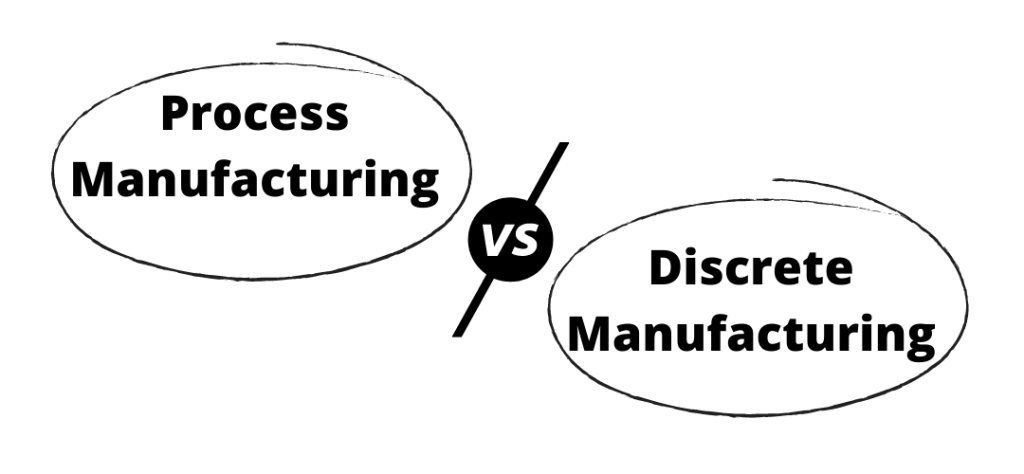Manufacturing is an intricate environment with several categories. However, in today’s post, we are going to focus only on the prevalent ones which are discrete and process manufacturing. They are interchangeably used and often thought of as 2 terms for a single system. But discrete and process manufacturing are two different methodologies. Our goal is to help you differentiate between the two, which we hope we will be able to accomplish by the end of this article.
Let’s begin!
So, what makes the manufacturing of computer different from that of medicine, say pills, or syrup?
It’s obvious you would say, the manner in which they are manufactured!
Correct, however, how will you describe this manner that you are referring to, to differentiate between the two?
Assembling different parts- CPU, display, integrated circuits comprising of different transistors, resistors, and other such components make a computer. It can be dismembered into different standard parts that are brought together for its manufacturing.
Now let’s talk about the other example- pills and syrup. They are made from mixing different types of salts and other compounds in certain units. Can a pill, for instance, say the one for headache be disintegrated into ergotamine tartrate, the compound that it is made of? Can you extract magnesia from Milk of magnesia? No, right? This is what makes discrete and process manufacturing different.
Now that you know the basics, let’s move further to the attributes of the two, to understand the difference in more depth.
-
Serving Industries
Industries that work on formulas or develop products from a recipe made of several ingredients implement process manufacturing. Paints and coating, food and beverages, chemicals, pharmaceutical industries, for example, use process manufacturing. But, discrete manufacturing involves the assembly line and its sub-assemblies. Consequently, industries like automobiles, electronics, defense, or space technology make use of discrete manufacturing.
-
Input
With process manufacturing, one can create products based on the recipe and formula which we measure in weight or volume. This is why quantity is important in process manufacturing. But in discrete manufacturing requires components in certain units or absolute quantity. The standardized quantity of the raw materials makes for the Bill of Material which discrete manufacturing utilizes.
-
Input Extraction
As mentioned in the example above, you cannot extract the ingredients from the final product created by process manufacturing. However, in discrete manufacturing, you can remove the standard components like IC, the motherboard in the case of a computer or motor, brakes in the case of automobiles.
-
Property of input materials
In process manufacturing the formula is susceptible to change if the physical property of the raw material such as the chemicals change, for example, the crystal structure, specific gravity, and similar characteristics. On the other hand, discrete manufacturing has fixed raw materials in BOM.
-
Product Identifier
You can produce products in bulk by process manufacturing. This is to say that you cannot differentiate between products of similar nature, like, medicine box. But because there is a production of unique output in discrete manufacturing, you can easily identify one product from another.
-
Production Yield Analysis
Yield analysis is done by making modifications in the output of a discrete manufacturing system. But this can also be done later to improve the quality of the output as per the consumer’s demands. However, in process manufacturing, the output is of varied quantity. Moreover, the analysis and modification in the latter should be done while the system is working. This will ensure the desired results.
-
Production Type
It is important to mention the production type as this is what helps in defining and adding features for the system be it process or discrete. If your business involves batch or continuous production like those in paints or chemicals, you should invest in a process manufacturing system. However, if its mass production like a range of cars, then you should implement the discrete manufacturing system because it is a good choice for a single job.
-
Order Type
If your business involves assembling, engineering, along with made to order and make to stock, discrete manufacturing is the solution for you. But if you have to follow repetitive orders for batch production, you should go for a process manufacturing system.
-
Manner
Process manufacturing involves blending, transforming, or mixing ingredients to make a product, on the basis of a formula or a recipe. But the discrete manufacturing, on the other hand, involves building, assembling, and fabricating products on the grounds of a bill of materials (BOM).
-
Compliance
Food and beverages or chemicals, medicines face recalls for not adhering to the protocols by FDA, EPA, MSDS. This is why it is important to follow the rules and regulations laid down by the governing bodies to ensure safe and healthy consumption or utilization. But this is not the case with the discrete manufacturing where regulatory compliance is not that stringent, and the quality analysis is done only for the sake of ensuring efficient workflow.
To sum up, let’s take the example of a car. The fuel for your car is a result of process manufacturing. But it is the discrete manufacturing system that makes the car.
Having read about both the system and their output in detail, it’s only natural to think that they require specific solutions. Yes, this is why you will need a separate solution provider for a recipe-based production such as the one tailored by us at Tayana Solutions to implement in your chemical factory or pet food manufacturing chain.

Vijay comes with a vast experience in ERP and enterprise solutions space with about 20 years of experience in various packaged application like Acumatica, SAP, Orion, Salesforce.com, SugarCRM and, SalesLogix.

